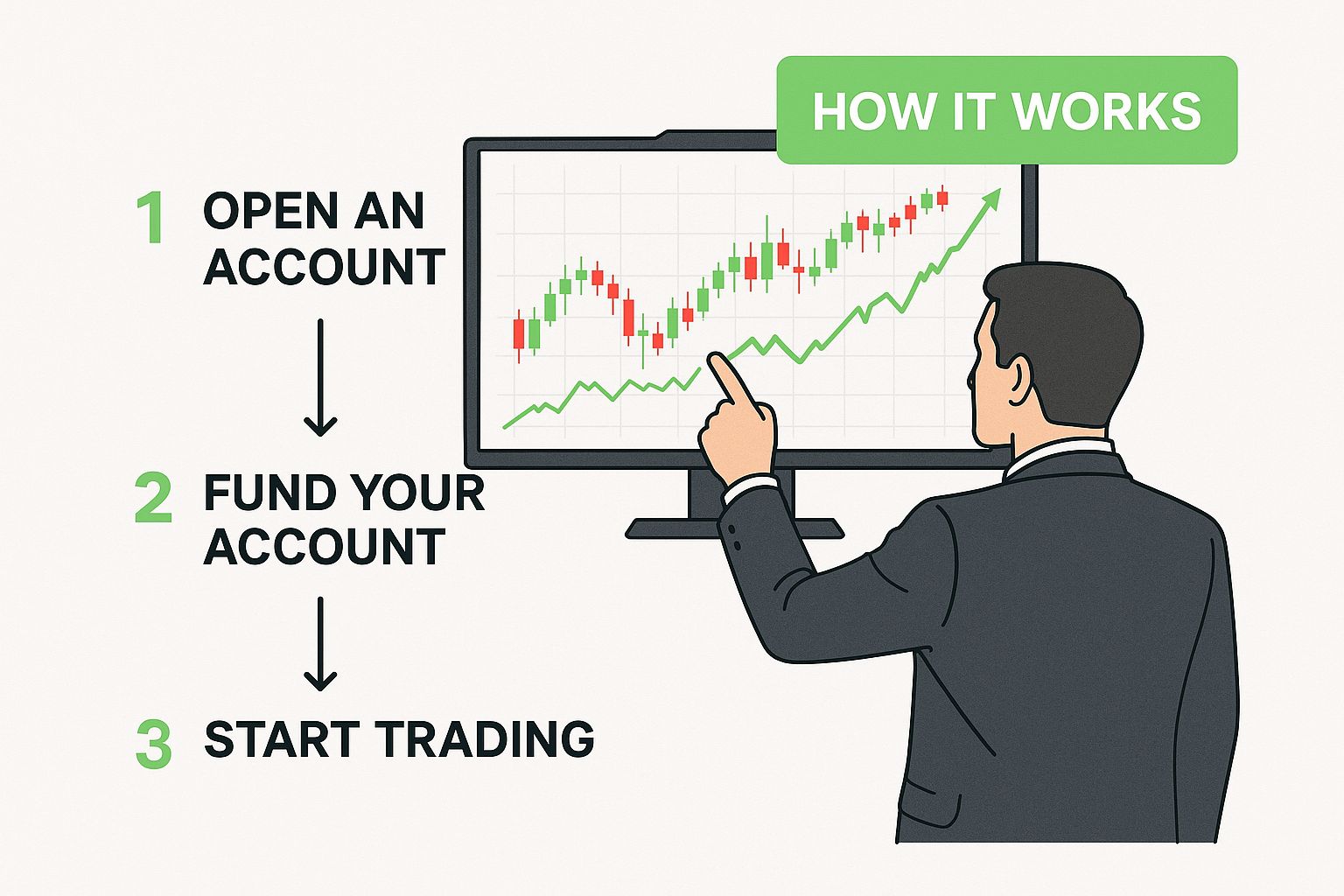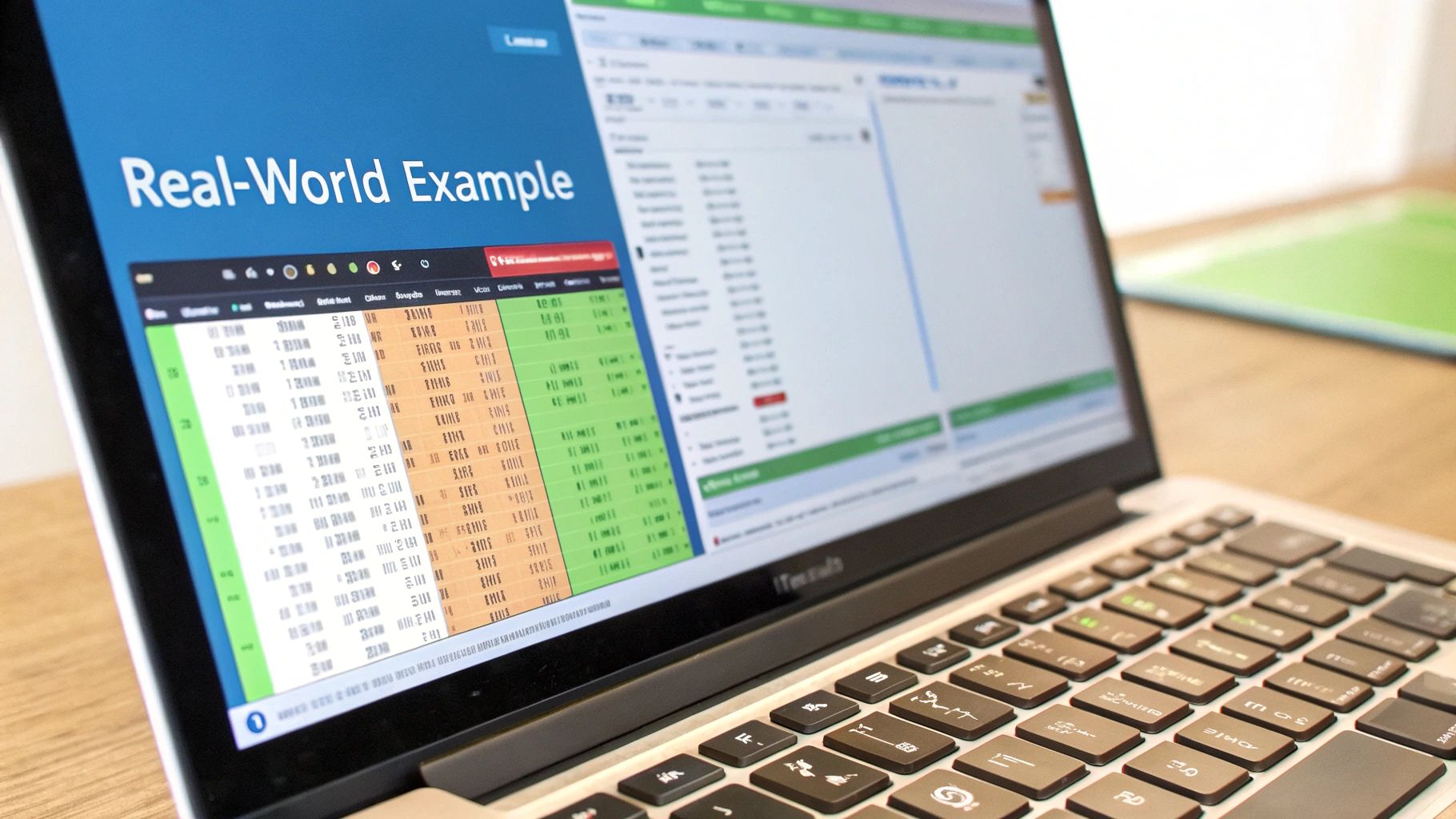What is a Short Call Option? Complete Guide & Risks Explained
If a stock moves past your strike, the option can be assigned — meaning you'll have to sell (in a call) or buy (in a put). Knowing the assignment probability ahead of time is key to managing risk.
Posted by
Related reading
poor man's covered calls: Boost income with less capital
Discover how poor man's covered calls can generate consistent income with less capital. Learn the strategy, risks, and actionable steps to trade smarter.
A Trader's Guide to Rolling Over Options
Learn the art of rolling over options. This guide covers real-world strategies for covered calls and puts to manage risk and enhance your returns.
At its core, a short call option is a contract where you, the seller, get paid cash today for promising to sell a stock at a specific price later on. You're selling someone else the right to buy that stock from you, and you collect an immediate payment—called a premium—for taking on that obligation.
This is a go-to strategy for traders who believe a stock is heading nowhere fast, or even a little bit down.
What a Short Call Option Really Means for You
Think of it like selling a special, non-refundable reservation ticket for an item you already own. Someone pays you a fee right now because they want the option to buy that item from you down the road, at a price you both agree on today.
If they decide it's not worth it and let the reservation expire? You just pocket the fee. Easy money.
That's the ideal outcome. You're essentially betting the stock won't rally past the agreed-upon sale price (the strike price) before the contract's deadline (the expiration date). When the stock stays put or drops, the buyer's "ticket" is worthless, and the premium you collected is 100% yours to keep, no strings attached.
But that upfront cash comes with a real commitment. If the stock does take off, you're on the hook to sell your shares at that lower, locked-in price. Because you profit when the stock price stays below the strike, it's considered a neutral to bearish strategy. You can get a more technical breakdown of how these contracts work from the Chicago Board Options Exchange.
Key Takeaway: When you sell a call option, your maximum profit is strictly limited to the initial premium you receive. Your obligation, however, can lead to significant risk if the stock price moves sharply against you.
To make this crystal clear, let's break down the moving parts of every short call trade.
Breaking Down a Short Call Option
A short call might sound complex, but it boils down to just three main components. The table below simplifies your role in the trade and uses a simple analogy to tie it all together.
| Component | Your Role as the Seller | Real-World Analogy |
|---|---|---|
| Premium | The immediate cash you receive for selling the option. | The fee someone pays you for a concert ticket presale code. |
| Strike Price | The fixed price you must sell the stock for if assigned. | The locked-in price for the concert ticket. |
| Expiration Date | The date the buyer's right to purchase the stock ends. | The deadline before the presale code becomes invalid. |
Once you understand these three pieces—the premium you collect, the price you might sell at, and the deadline—you've grasped the core mechanics of selling a call option.
How Selling a Call Option Actually Works
Okay, so you get the big picture. But what does a short call trade actually look like from start to finish?
It all begins when you place a “sell to open” order in your brokerage account. Think of this as putting a contract up for sale on the open market. The moment a buyer takes it, the premium—cold, hard cash—lands directly in your account.
That money is yours to keep, no matter what happens next. You’ve now created a short call position, which means you’re on the hook to sell 100 shares of the stock at the strike price if the buyer decides to exercise their option. From here on out, your main job is to watch the stock's price and hope it stays below your chosen strike until the option expires.
This image breaks down the typical journey of a short call seller.

As you can see, once you’ve collected that initial premium, the fate of your trade really just depends on where the stock price goes relative to your strike price.
The Three Potential Outcomes
Every single short call trade ends in one of three ways. It's critical to understand these before you even think about placing a trade, because each one has a totally different impact on your account.
Key Insight: Time decay, or theta, is the short call seller's best friend. Every single day that passes, the option loses a little bit of its time value, pushing the trade one step closer to a win for you.
Here’s how it can all shake out:
The Option Expires Worthless: This is the home run. If the stock price is at or below your strike price when the expiration date hits, the option is "out-of-the-money" and becomes worthless. The contract simply disappears, your obligation is gone, and you keep 100% of the premium you collected as pure profit. Game over, you win.
The Buyer Exercises the Option (Assignment): If the stock price shoots up past your strike, the option is "in-the-money," and the buyer is almost certainly going to exercise their right to buy the shares. You'll be assigned, which is just a fancy way of saying your broker will automatically sell 100 shares of the stock from your account at that agreed-upon strike price.
You "Buy to Close" the Position: You don’t have to ride it out until the very end. At any point before expiration, you can exit the trade by buying back the exact same option contract. Traders do this all the time, either to lock in a decent profit early or to cut their losses and live to fight another day if the trade starts moving against them.
Your Potential Profit and Loss Scenarios
Theory is great, but let's be honest—seeing how a trade plays out with real numbers is where the lesson truly sticks. We'll walk through a clear example to show you exactly how money is made or lost with a short call.
Let's say stock XYZ is trading at $48 per share. You're pretty confident it's not going to break above $50 in the next month. So, you decide to sell one short call option with these specs:
- Strike Price: $50
- Expiration: 30 days from now
- Premium: $2.00 per share (which is $200 for one contract)
The second you sell that option, the $200 premium lands in your brokerage account. That's your maximum profit on this trade, and it's yours to keep no matter what happens next.
Your Best Case Scenario Profit
The best possible outcome? XYZ stock closes at or below the $50 strike price when the option expires. Whether it finishes at $49, $48, or even right on the dot at $50, the option expires completely worthless.
Why? Because the buyer has no reason to use their contract to buy shares from you at $50 when they could just get them cheaper (or for the same price) on the open market. The contract vanishes, your obligation is gone, and you pocket the full $200 premium as pure profit. This is the bread and butter for most income-focused traders and a cornerstone of many options income strategies.
Your Worst Case Scenario Loss
Now for the risky part. What if you're wrong and XYZ stock doesn't just climb, it soars to $57 per share by expiration? The option is now "in-the-money," and you can bet the buyer is going to exercise their right to buy those shares from you at the much lower $50 strike price.
If you sold this call "naked"—meaning you didn't own the 100 shares beforehand—you now have to go out on the open market, buy 100 shares of XYZ at the current $57 price, and turn around and sell them to the option buyer for the agreed-upon $50 strike price.
The Hard Math: You're losing $7 per share on that stock transaction ($57 purchase price - $50 sale price). For a 100-share contract, that's a $700 loss. After you factor in the $200 premium you collected upfront, your net loss for the trade is $500.
This example cuts right to the heart of a short call's risk profile: your potential profit is always capped at the premium you received, but your potential loss is, in theory, unlimited. The higher the stock price goes, the more you stand to lose.
Facing the Uncapped Risk of Short Calls

Let's be perfectly clear about the primary danger of selling a short call. When you sell an option without owning the underlying stock—a position known as a “naked call”—you're stepping into one of the riskiest strategies in the entire market.
The reason is simple but absolutely brutal: your potential for loss is, in theory, infinite.
If the stock price skyrockets, you’re still locked into your obligation to sell at the much lower strike price. This forces you to go out and buy shares on the open market at an ever-increasing cost, only to immediately sell them for a massive loss. The higher the stock climbs, the deeper your financial hole gets. It's this lopsided risk profile that has wiped out countless traders.
Studies consistently highlight these dangers. A London Business School analysis of retail trading from 2019 to 2021 found that traders collectively lost over $2 billion on options. High-risk strategies like naked short calls were a major reason why. You can dig into more of these options trading statistics on QuantifiedStrategies.com.
Given this immense exposure, you have to ask: how can anyone possibly manage this kind of risk?
The Covered Call Solution
Fortunately, there’s a widely used method that completely transforms this strategy from a high-stakes gamble into a defined-risk income generator. It’s called a covered call.
The idea is straightforward: you only sell a call option if you already own at least 100 shares of the underlying stock. Those shares you hold are your "cover," completely removing the nightmare scenario of having to buy them at a loss on the open market if you're assigned.
This one simple adjustment changes everything:
- Risk Transformation: Instead of unlimited losses, your risk is now defined. Your only "risk" is being forced to sell shares you already own at a price you were happy with.
- Income Generation: The goal shifts from pure, risky speculation to a method for earning extra income on stocks you've already decided to hold in your portfolio.
By making sure your obligation is covered, you sidestep the number one danger of a naked short call. Understanding when to sell covered calls is the crucial next step for anyone looking to generate income safely. Respecting the risk is always the first rule before placing a trade.
When This Strategy Makes the Most Sense

Selling a call option isn't a strategy you can just throw at any stock. It's a specific tool for a specific job, and it works best when you have a neutral-to-bearish outlook on a company. In simple terms, you believe the stock's price is going to stay flat, trade in a tight range, or maybe even drift down a bit.
When you see a stock in this kind of holding pattern, a short call lets you turn that stagnation into cash. Instead of just sitting on your hands waiting for a big move that might not happen, you collect a premium right away. You’re essentially getting paid for your prediction that the stock isn't going anywhere exciting.
The ultimate goal? For the option to expire worthless, allowing you to pocket the entire premium. This becomes a high-probability outcome when the stock behaves just as you anticipated.
Ideal Conditions for Selling Calls
Certain market setups make selling a short call more appealing and potentially more profitable. Timing is everything, and spotting these conditions can make a huge difference in your results.
- Neutral or Range-Bound Stocks: You've found a stock that just seems "stuck" in a price channel, with no major news or events on the horizon that could send it soaring.
- Post-Earnings Announcement: The hype after an earnings report often dies down quickly. This can be a great time to sell calls, as the stock price tends to settle into a more predictable, less volatile pattern.
- Slightly Bearish Outlook: You think a stock is more likely to dip than to rally, but you aren't confident enough to short it directly. Selling a call lets you profit if you're right—or even if the stock just treads water.
Key Insight: One of the best times to sell a short call is when a stock's implied volatility (IV) is high. High IV inflates the option's premium, meaning you get paid more for taking on the same amount of risk.
But there's a catch. High IV also means the market is expecting bigger price swings, making it a classic double-edged sword. This is where solid trade construction and smart options risk management become critical. You have to balance the temptation of a bigger premium with the very real risk of a sharp move against you.
Answering Your Key Questions
Now that we’ve walked through the mechanics of selling calls, let’s tackle some of the most common questions that come up. Getting these concepts straight is key to building your confidence and avoiding costly mistakes.
What Is the Main Difference Between Buying and Selling a Call?
Think of it as two sides of the same bet. When you buy a call, you're betting on a stock to go up. When you sell a call, you're betting on it to stay flat or go down.
Your profit is the buyer's loss, and vice-versa.
- Selling a Short Call: You get paid a premium upfront and take on the obligation to sell a stock at the strike price. Your goal is for the stock to stay below that price.
- Buying a Long Call: You pay a premium for the right (but not the obligation) to buy a stock at the strike price. Your goal is for the stock to shoot above that price.
Can I Really Lose More Than the Premium I Collect?
Yes, and this is the most critical risk to burn into your brain. With a "naked" or uncovered short call, your potential loss is theoretically unlimited.
Your profit is capped at the small premium you collected at the start. But if the stock price keeps rocketing higher, your losses can balloon far beyond that initial payment. This is what makes selling naked calls an extremely high-risk strategy if you don't own the underlying shares.
How Does a Covered Call Make This Strategy Safer?
A covered call is the go-to method for traders to tame that unlimited risk. It's simple: you only sell a call option on a stock that you already own (at least 100 shares per contract).
Owning the shares completely changes the game. It "covers" your obligation.
Key Takeaway: With a covered call, you're no longer exposed to infinite losses. If you get assigned, you don't have to scramble to buy expensive shares on the open market. You just deliver the shares you already have in your account. This transforms the strategy from a high-stakes gamble into a smart way to generate income from your portfolio.
What Happens if a Short Call Is Assigned to Me?
If the stock closes above your strike price at expiration, the buyer will almost certainly exercise their right to buy your shares. This is called assignment.
When you're assigned, your broker automatically handles the transaction. They will sell 100 shares of the stock from your account at the strike price. If it was a covered call, the shares you own are sold. If it was a naked call, you'll be left with a short stock position of 100 shares—which you now have to buy back to close out the trade.
Ready to stop guessing and start selling options with data-driven confidence? Strike Price provides real-time probability metrics for every strike price, helping you balance safety and premium yield. Our platform sends smart alerts for high-reward opportunities and early risk warnings, turning what feels like a gamble into a strategic, income-generating process. Learn more and see how Strike Price can work for you.